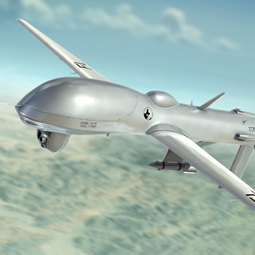Drone Wars: The Morality of Robotic Weapons

One dramatic example of the use of military drones (unmanned aerial vehicles) recently grabbed headlines throughout the world.
Soon after the tragic and unjust killing of four Americans in Benghazi, Libya (including Chris Stevens, the U.S. ambassador to Libya), on the anniversary of 9/11, reports circulated that the deaths were a pre-planned and coordinated attack in retaliation for the killing earlier this year of Abu Yahya al-Libi, a top al-Qaida leader from Libya.
Yahya al-Libi was killed in North Waziristan on the Pakistan-Afghanistan border, most likely by a U.S. drone attack with "hellfire missiles."
With drone technology rapidly becoming ubiquitous, many people ask: Is the use of drones for surveillance, identification and aerial attack in accordance with the Catholic moral tradition?
New technology does not change moral truth. The basic ethical norms are unchanged and unchangeable because they reflect how humans are to flourish individually and as a community of persons on our pilgrim path towards God and his Kingdom.
However, new technology does provide new challenges in applying these moral norms.
The use of drones in war falls under the same category as the use of manned aircraft. The moral presumption is that one should not employ deadly force.
But there are exceptions to this presumption if one is justly defending others. This is true domestically (police actions for example) or internationally (fighting in a just war). For a war to be just it must meet very stringent conditions: be fought for a just cause, as a last resort, with the right intention, declared by the competent authority, with a probability of success and be proportionate (in the sense that the goods to be protected and promoted are proportionate to the assumed damage the war will most likely cause).
These criteria are the jus ad bellum (justice of war) requirements.
But a just war must be fought justly, so there are also jus in bello (justice in war) criteria that must be followed. These include that each action be militarily necessary to achieve the just cause, be done for the right intention, be part of a lawfully ordered action, have a probability of success, inflict minimum loss of life or injury while demonstrating proportionality in the good achieved vs. the damage inflicted on the enemy, and properly discriminate between legitimate military targets and innocent non-military civilians.
If the "war on terror" is not a just war, then no action in it can be just. The only moral course would be to cease fighting. However, assuming the "war on terror" is a legitimate application of the jus ad bellum criteria (an assumption not without many difficulties given that, among other things, it is an unconventional, asymmetric war), does the use of drones meet the jus in bello requirements?
Before answering this question, the decision-making procedure for a drone strike should be examined.
Due to the excellent work of investigative journalists like Esquire’s Tom Junod, the Council on Foreign Relations’ Jonathan Masters and Jo Becker and Scott Shane of The New York Times, a fairly clear picture has emerged. "Targeted killings," as they are sometimes called, are authorized on al-Qaida operatives (and their supporters or allies like the Taliban) only after they have been placed on the unfortunately named "kill list."
This list is drawn up at the highest level of the American political and military chain of command. Names are added only with the direct approval of the commander in chief, the president of the United States.
President Barack Obama is frequently briefed on terrorist activity and reserves his right to have the final say in authorizing strikes. According to the Times, he personally authorizes all strikes in Yemen and Somalia and many in Pakistan.
All strikes must meet strict "rules of engagement" when it comes to identifying some high-value person of interest or group on the approved attack list. A strike may be a deployment of special forces in a "capture or kill" mission, a cruise missile launch or an aerial bombardment from manned or unmanned aircraft.
More often than not, the weapon of choice is a missile strike from a drone.
Drones have several military advantages. They offer little or no risk to the U.S. forces. They are less expensive and dangerous than maintaining manned aircraft on station. They can remain in the air for an incredibly long time, and they have proved both deadly and accurate.
The New America Foundation, a widely accepted non-partisan analyst, estimates there have been approximately 337 drone strikes in Pakistan alone from 2004 until Oct. 24, 2012 (about 285 of these occurred during Obama’s presidency) causing casualties of between 1,908 to 3,225 people. These strikes have killed 1,618-2,769 combatants, about 153-192 civilians and another 130-268 persons whose identities were unknown.
This means the collateral-damage estimates range from 7%-15%. Over time, this figure has decreased, as targeting methods, technology and technical skills of the remote pilots have all improved.
Compared to other methods of attack and other wars, these collateral-damage figures, though still tragic, are fewer.
These statistics make clear that U.S. military authorities are seriously attempting to minimize civilian casualties and make these attacks as "surgical" as possible. And we know from captured documents and other intelligence that these strikes have seriously hampered al-Qaida’s efforts to carry out terrorist activities and recruit and train new leadership.
Therefore, these strikes seem to be serving a real military purpose (just cause) in the ongoing battle to disrupt terror activity.
One might ask if these strikes are not tantamount to murder, since they intend to kill.
In fact, the intent is to sever the command, control and communication (CCC) ability of these terror groups by striking at their key leaders and command posts. Each terror leader is a walking CCC nerve center vital to the enemy’s ability to continue their threat to innocent human life. The intent of any attack in these cases is morally similar to a police attack on kidnappers in a hostage situation who refuse to surrender and continue to threaten others. There seems to be a right intention here.
This leaves four more problematic questions.
First, although we are not there yet, this increased reliance on remote technology does give one reason to pause and ask whether such mechanization threatens to make war (and everything else) even more inhumane. Does this increased reliance on technology create a new "arms race," where the chase is for ever-increasing electronic sophistication, with more and more automation? Is there a point where we humans might lose control of our own machines? Already, the use of automatic drones which would be programmed to search, identify and fire on targets without direct human intervention is being considered. This "brave new world" would be fraught with real ethical dilemmas.
Second, shouldn’t we pay more attention to the requirements of minimum force and make an attempt to capture these terror operatives rather than "shooting first and asking questions later"? After all, morality requires the use of deadly force as a last resort. And from an "intel" perspective, a captured operative can be extremely helpful, while a dead one cannot.
While this is true, and every reasonable effort should be made to capture rather than kill, the terrain, political situation, operative style and patterns of these terror leaders make capture a near impossibility. This being said, it would be in better keeping with the just-war tradition if more were done to try to capture these "high-value targets."
Third, what are the legal implications of such attacks, given that many take place in countries like Pakistan, Somalia and Yemen, where the U.S. and her allies technically are not engaged in an ongoing war?
Here, to meet the criteria of lawful action, there must be at least the tacit approval of these governments. The only exception would be where the government is actively aiding and abetting the terror organization. Then the offending nation would be subject to attack, as Congress authorized in its resolution on the use of force against al-Qaida and other terror groups (passed first in September of 2001 and renewed as recently as this year).
This tacit approval is becoming a real issue, especially as the U.S. relationship with some of these nations is highly problematic.
Last, but certainly not least, there is the question of last resort. Doesn’t the use of drone technology lessen the natural barrier to authorizing the use of deadly force? Isn’t it much easier to give a "go" order to attack when none of your military personnel is being placed in harm’s way?
When a nation asks a soldier to risk life and limb, any decent commander will think long and hard before sending in the troops, knowing what is being risked. But if all that is at stake is some hardware that can be programmed to self-destruct, what is there to give a leader pause, except his or her well-formed conscience and empathy for one’s enemies?
If we look at history, neither of these characteristics has been in high supply among the emperors, kings, princes, prime ministers and presidents who have ruled their respective nations. Perhaps, in the end, this new technology will call for new types of leaders, not ruthless and cunning, ambitious and grasping, but ones who truly are empathetic and sacrificing, who are filled with compassion and "love of enemy" (see Matthew 5:44).
But where will these saints be found? As technology advances, mankind’s moral progress and even survival may depend on our answer to this question.
Msgr. Stuart Swetland, a 1981 graduate of the U.S. Naval Academy, holds the Archbishop Harry Flynn Chair of Christian Ethics
at Mount St. Mary’s University in Emmitsburg, Md., and is the host of EWTN’s
Catholicism on Campus. He served six years as a line officer in the U.S. Navy.
- Keywords:
- November 18-December 1, 2012
















